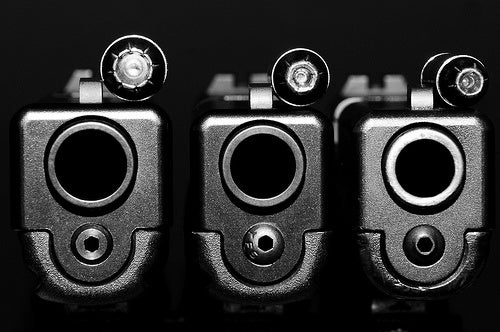Recently, I ran across a fantastic article from training John Farnam on his perspective on the use of aftermarket drop-in barrels on Glock handguns (can be found here). In general, I agree with much of what he has said, but I think its a little too much blanket advice with not enough information.
*Author’s disclosure – I am employed by a barrel manufacturer who makes Glock handgun barrels.
This may not be a full rebuttal, but rather added information that helps put Mr. Farnam’s assertion into perspective and focus on what’s important of the points of what I believe with what he was driving towards.
“Fully Supported Chambers”
Mr. Farnam contends that one should not use a barrel that has a “fully supported chamber” as Glocks were designed only to fire new ammunition, allowing for some bulge. I disagree, especially having shot .40 cal Glocks extensively. The unsupported base of the brass over the feed ramp can cause dangerous bulging, not just little bulging. In 15,000 rounds, I have had two rounds blow out brass, both new factory ammunition, causing a major malfunction.
I contend “Supported Chambers” is a critical need for the shooting of higher pressure rounds, especially like .40 and .357 SIG. In the Glock, 9mm is already “fully supported” so the point on aftermarket barrels in this caliber is moot. Yes, the feed ramp will be steeper, but its up to the shooter to verify that their combination of parts functions, as should be the case with even a factory new Glock handgun.
“Tight Chambers”
While Mr. Farnam does mention that not all aftermarket barrels “(just) many, probably most…” have tight chambers, the reader walks away believe that just about all barrels have tight chambers and therefore should not be used in a handgun for “serious” purposes.
What a shooter should be looking for is a SAAMI compliant chamber. So long as the chamber is SAAMI compliant, it will be safe and functional to shoot, even at the bottom end of the specification. As such, it’s important for Mr. Farnam to dictate what he means by “tight”. If he refers to non-SAAMI chambers, he is correct.
If just referring to headspacing, the handgun will be OK, as ammo manufacturers make ammo to be compliant with the entire specification. Almost every barrel is manufactured to SAAMI and if not, the barrel should not be used without careful understanding of what the OEM did to modify the chamber.
Mr. Farnam then goes into tightly-fitted guns not being recommended. This is not relevant to a tight chamber. For example, the AK has properly headspaced and often tight chambers to start accounting for the wear on the gun over its lifetime and is not considered a “tightly fitted” gun.
“Cut Rifling”
In this section, I do not get what Mr. Farnam is implying with the statement: “Polygonal rifleing, found on factory Glock barrels, requires sophisticated industrial processes, out of reach for most small accessory manufacturers.” If anything, it seems to state that polygonal is superior just due to the cost of the machines to manufacture it and that cut is inferior.
If that is indeed the logic, it is patently untrue. 5R and other types are well with reach of most OEMs. Secondly, the overall quality of the barrel is far more important than the type of rifling. These small OEMs are often able to make a better barrel than Glock if only because they have the ability to make margin on an individual part.
As Mr. Farnam cedes, it has greater compatibility with a larger array of bullets, including unjacketed ammuntion. With Glock barrels not being known for fantastic accuracy, why try to make a point on rifling type when the quality of the bore from an the aftermarket is generally considered better?
Conversion Barrels
No rebuttal from me here. Just don’t do it for a serious defense firearm unless one completely and totally swaps to the intended calibers parts including slide, barrel, ejector, etc, which is possible on a Glock.
What Is He Really Going For?
Reading into the post, I can see what Mr. Farnam is going for, which is a general advisement on avoiding aftermarket barrels manufactured to a tighter fitment than the OEM part, but the thing is that most of the aftermarket is manufactured to tighter tolerance, not tighter fit.
To me, don’t be afraid of the aftermarket parts, especially when they allow one to improve upon the platform with greater compatibility with ammo, better accuracy, and added features (notably threading) that OEM does not provide.
So, the age-old adage of test your gun and ammo applies yet again.
**Update – 2.28.2017 – My apologies to Mr. Farnam for misspelling his name. No slight was intended in any form, just a mistake on my side.
 Your Privacy Choices
Your Privacy Choices
